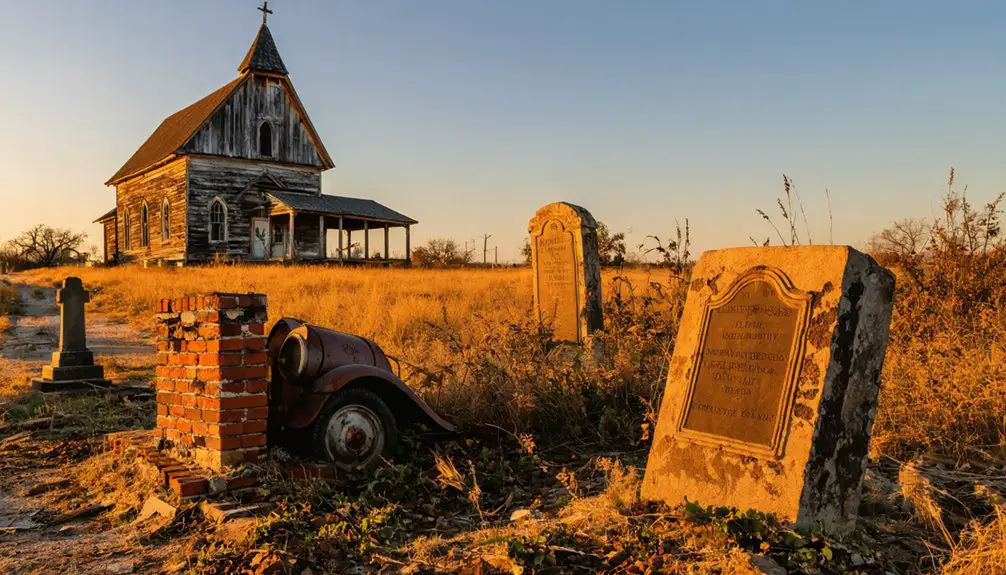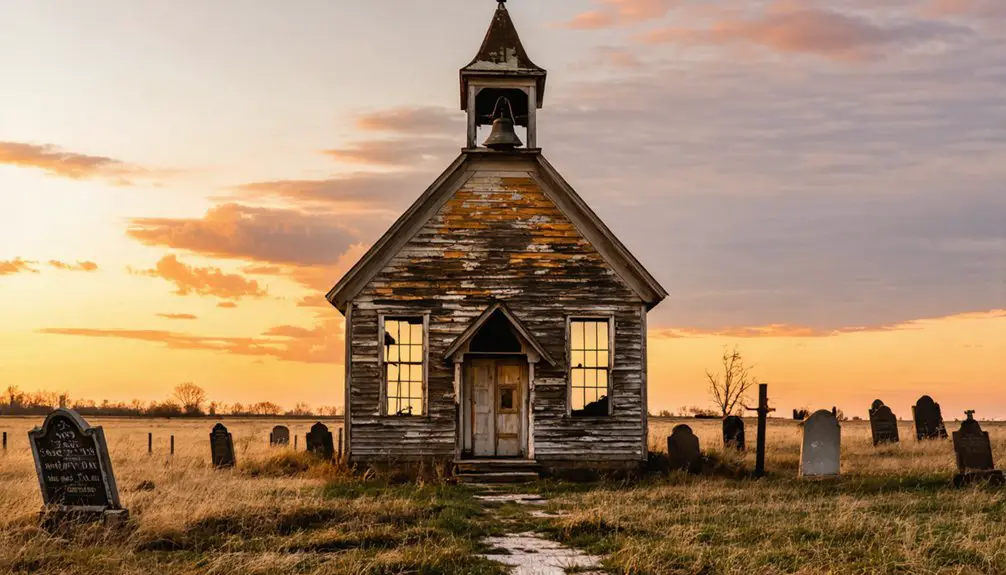You’ll find Antioch, Oklahoma 10 miles west of Pauls Valley, where a once-thriving farming settlement emerged in the 1880s. The town’s post office operated from September 6, 1895 to May 14, 1932, serving as an essential community hub during its peak years. Cotton, corn, and broomcorn farming sustained early settlers, but the Great Depression and transportation changes led to its abandonment. Today, scattered foundations and artifacts invite you to explore this plains ghost town‘s fascinating story.
Key Takeaways
- Antioch was established in 1895 as a farming settlement in Garvin County, Oklahoma, located 10 miles west of Pauls Valley.
- The town’s post office operated from September 1895 until May 1932, marking its vital period of community activity.
- Economic decline accelerated during the Great Depression, with over 80% of residents leaving due to depleted resources and agricultural challenges.
- Natural disasters, including the Dust Bowl and floods, combined with transportation isolation, contributed to Antioch’s transformation into a ghost town.
- Today, only foundations and scattered artifacts remain at the site, located at coordinates 34°43′30″N 97°24′20″W.
The Rise of a Rural Settlement
During the 1880s, Antioch emerged as a farming settlement in Garvin County, Oklahoma, positioned approximately 10 miles west of Pauls Valley.
You’ll find that the early settlement patterns centered around strategic transportation routes, making it easier for farmers to distribute their crops to market. Similar to other frontier towns, deep water shipping played a crucial role in development and trade. Like the ancient city of Antioch that developed around trade corridors, this settlement established itself at key crossroads. As settlers established their presence, they built homes, developed farmland, and created basic road networks essential for the community’s growth.
The town’s agricultural practices shaped its early development, with cotton, corn, and broomcorn becoming the primary crops.
You can trace the town’s expansion through the establishment of supporting businesses, including a cotton gin that processed the local harvest. The settlement’s layout followed traditional rural Oklahoma surveying methods, with land ownership carefully mapped to accommodate the growing farming community.
Post Office Legacy: 1895-1932
The establishment of Antioch’s post office on September 6, 1895, marked a new chapter in the settlement’s development beyond its agricultural roots. Located 10 miles west of Pauls Valley, the post office served as your important link to the outside world for 37 years.
Antioch’s post office arrival in 1895 transformed the farming settlement, connecting its people to the broader world for nearly four decades.
You’ll find that postal services weren’t just about mail – they created a powerful community connection that helped sustain the rural town’s identity until its closure on May 14, 1932. Similar to the oral history interviews collected from rural Oklahoma communities, these postal facilities captured important stories of daily life and local heritage. Like the cemetery records documented in Mississippi communities, these facilities preserved vital information about local residents.
- Local postmasters managed mail operations while steering through community challenges like gambling and bootlegging.
- Staff members regularly interacted with farmers and ranchers, becoming pillars of daily life.
- The facility enabled significant business correspondence for agricultural operations.
- Mail service proved essential when transportation options were limited.
- The post office’s closure during the Great Depression signaled Antioch’s decline into a ghost town.
Life in Early Antioch
When pioneers first arrived at Antioch’s site in 1850, they established a temporary camp near what you’ll find today as F Street.
Like the Plains Apache tribes who had inhabited the region centuries earlier, these settlers strategically chose locations near water sources.
You’ll notice how settler cooperation shaped early community life, as Captain Kimball designed the town in blocks, with the first five houses built along Second Street during that initial winter.
Life wasn’t easy for these freedom-seeking pioneers. Agricultural challenges struck hard when drought devastated their first crops, forcing them to adapt. They discovered cave drawings nearby, similar to those found near Kenton, Oklahoma, suggesting ancient human presence in the area.
They’d trek to Kirker Pass to harvest wild oat grass, selling it in San Francisco for $60 per ton. Most settlers returned to Antioch after the drought, gathering on July 4, 1851, to officially name their settlement after Antioch of Syria, honoring the recently deceased Reverend Joseph Smith.
Geographic Setting and Natural Features
Nestled approximately 10 miles west of Pauls Valley in Garvin County, Oklahoma, Antioch’s geographic coordinates mark its location at 34°43′30″N latitude and 97°24′20″W longitude. Modern mapping tools can pinpoint this location using UTM coordinates 14S.
You’ll find this ghost town‘s topographical features shaped by the South Canadian River watershed, with gently rolling plains that proved ideal for its agricultural history. Much like ancient Antioch’s position along the Orontes River gorge, the area’s waterways were vital to early development.
- Mixed grass prairie and scattered woodlands define the natural vegetation
- Elevation ranges between 800 to 1,200 feet above sea level
- Annual rainfall of 35-40 inches supported farming ventures
- Rich soil conditions favored cultivation and pastureland
- Small creeks and groundwater sources sustained early settlers
The area’s temperate climate delivers four distinct seasons, with hot, humid summers and mild winters.
The terrain’s characteristics made it particularly suitable for farming and ranching activities that once defined life in this now-abandoned settlement.
The Decline Years
The final closure of Antioch’s post office in the late 1950s marked a critical turning point in the town’s decline, as this essential community hub had served local residents since Oklahoma’s early territorial period.
Similar to many of Oklahoma’s estimated two thousand ghost towns, Antioch fell victim to the changing landscape of rural communities across the state.
You’ll find that Antioch’s economic downturn accelerated through the 1960s when changes in regional transportation routes diverted commerce away from the once-bustling settlement.
The town’s remaining families gradually relocated to larger communities throughout the 1970s, leaving behind abandoned storefronts and empty homes that stand as silent reminders of Antioch’s more prosperous days.
Much like the impact on other Oklahoma settlements, the Great Depression contributed significantly to Antioch’s initial population loss and economic struggles.
Post Office Final Days
As economic hardships intensified during the Great Depression, Antioch’s post office operations drew to a close on May 14, 1932, marking a significant moment in the town’s decline.
For nearly four decades, this essential community hub had served local residents from its location 10 miles west of Pauls Valley. The loss of postal services struck a devastating blow to Antioch’s remaining infrastructure and social fabric.
- Mail processing and delivery ceased after 37 years of continuous operation
- Local businesses lost their primary connection to outside commerce
- Residents were forced to travel to neighboring towns for postal services
- Community gatherings at the post office ended, fragmenting social bonds
- Federal recognition of Antioch as an active settlement officially terminated
Economic Forces Take Hold
During the pivotal 1890-1910 period, Antioch’s mainly agrarian economy faltered as America’s industrial revolution gained momentum. You would’ve witnessed the town’s struggle to adapt as farming’s importance declined and industrial jobs became concentrated in larger urban centers.
The lack of economic diversification left Antioch particularly vulnerable. The industrial shift bypassed many small Oklahoma towns like Antioch, creating a domino effect of decline.
When the Great Depression hit in the 1930s, it delivered a crushing blow to an already weakened economy. You’d have seen local businesses shuttering their doors as residents moved away in search of work.
The town’s isolation from major transportation routes further complicated recovery efforts, while the erosion of basic services – from grocery stores to churches – accelerated the community’s economic downfall.
Population Exodus Patterns
Once natural resources began depleting in Antioch during the early 1900s, you’d have witnessed a dramatic population exodus that mirrored patterns seen across Oklahoma’s 2,000 ghost towns.
The town’s decline accelerated as resource depletion triggered widespread population migration, with over 80% of residents leaving their homes behind.
- Families packed up and left as employment opportunities vanished with the exhaustion of local resources.
- The Great Depression and Dust Bowl of the 1930s drove even more residents to seek opportunities elsewhere.
- Railroad reroutings and highway bypasses cut off essential transportation links to Antioch.
- World War II’s economic shifts pulled remaining residents toward urban industrial centers.
- Environmental challenges like floods and droughts dealt the final blow to Antioch’s dwindling population.
Historical Significance and Modern Remnants

While many Oklahoma ghost towns boast dramatic tales of oil booms or lawless frontiers, Antioch’s historical significance lies in its representation of typical rural settlement patterns during Oklahoma’s territorial expansion.
You’ll find the town’s legacy preserved in its geographic coordinates at 34°43′30″N 97°24′20″W, about 10 miles west of Pauls Valley.
The community’s historical artifacts span from its 1895 establishment until the post office’s closure in 1932, marking nearly four decades of community heritage.
Today, you can explore the site’s remaining foundations and scattered remnants, though few structures still stand.
Like thousands of other Oklahoma ghost towns, Antioch tells the story of rural America’s evolution, where changing economic forces and transportation routes determined a community’s fate.
Frequently Asked Questions
Are There Any Surviving Photographs of Antioch During Its Active Years?
Like footprints in shifting sand, Antioch’s historical documentation has vanished with time. You won’t find any surviving photographs during its active years in Oklahoma’s historical archives or collections.
What Were the Names of the Postmasters Who Served in Antioch?
You won’t find reliable records of Antioch’s postmaster history in public databases, though postal services operated there from 1895-1932. You’d need to check Oklahoma Historical Society archives for names.
Did Any Notable Crimes or Incidents Occur in Antioch’s History?
As you walk the empty prairie, you won’t find records of major crimes. While local legends whisper of mysterious disappearances, no documented incidents appear in historical archives or law enforcement records.
Were There Any Churches or Schools Established in Antioch?
You won’t find documented evidence of established churches or schools in Antioch’s church history or education impact, though informal religious gatherings and basic schooling may have existed during its brief existence.
What Was the Peak Population of Antioch Before Its Decline?
While population statistics weren’t officially recorded, you can estimate Antioch’s peak at several hundred residents given its historical significance as a town substantial enough to maintain postal services from 1895-1932.
References
- https://www.okhistory.org/publications/enc/entry?entry=GH002
- https://en.wikipedia.org/wiki/Antioch
- https://www.wikiwand.com/en/articles/Antioch
- https://kids.kiddle.co/List_of_ghost_towns_in_Oklahoma
- https://pastmaps.com/explore/us/oklahoma/garvin-county/antioch/hiking-exploration
- https://antiochhistoricalmuseum.org/early-antioch-history/
- https://npgallery.nps.gov/GetAsset/87bb3e76-2a46-47ac-9bd5-3f36fb18d5b0
- https://www.okhistory.org/shpo/docs/ruralschoolsswok.pdf
- https://kids.kiddle.co/Antioch
- https://okhistory.org/research/findingaid?id=001gkx



